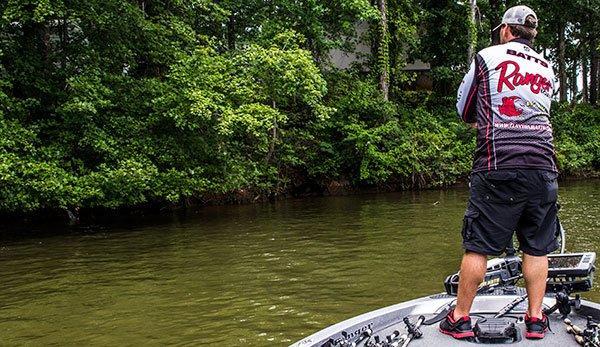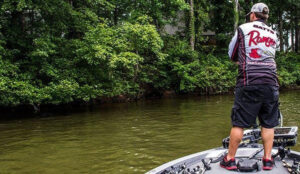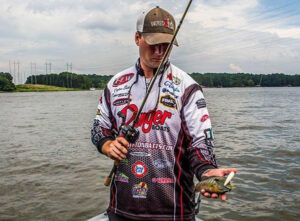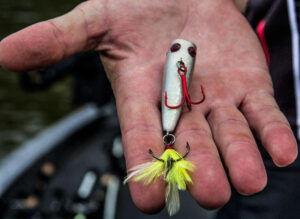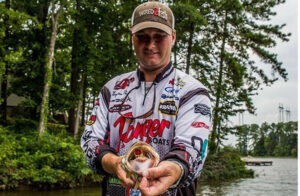If you fish a lot during the summer, you’ve probably had a few encounters with mayflies. Whether you’ve seen them covering docks and overhangs, had them coat your boat or inadvertently sucked them into your nose or throat, these large, black insects are hard to miss. Although they can be a nuisance for humans, it’s important to recognize that mayfly hatches can play an integral role in summer bass fishing.
Everstart pro, FLW Tour co-angler and Georgia fishing guide Clayton Batts often capitalizes on mayfly hatches during the summer months. During the heat of the summer when fishing can be toughest, fishing mayfly hatches gives him a chance to catch big bass in super shallow water. His 5 tips can help deliver you from the summertime blues.
1. Shake the trees to start a feeding frenzy
Mayfly hatches most often occur after a light, overnight rain, making the following days a gold mine for giant bass. In these situations, Batts spends a lot of time idling the banks looking for black “blobs” on overhanging trees and bushes. When he sees a stretch of bank littered with newly hatched mayflies, he puts a SPRO Bronzeye Poppin’ Frog to work, but it takes a while before it even touches the water.
“I like to go down the bank with my trolling motor on about 75 percent and throw the frog into any bushes or trees that have mayflies in them,” Batts said. “After I shake trees for about 100 yards, I’ll idle back to where I started and begin fishing.”
As the newly hatched mayflies are knocked into the water, bream will often swarm the area to take advantage of the easy meal. Where there are large quantities of active bream, big bass will never be far behind.
“It’s important to be pretty quick when you’re doing this,” Batts said. “It doesn’t take a school of bream very long to eat all the mayflies, so you’ve got to be fishing while the bream are still popping the surface. The bass will usually hang around any shady areas, which is why I make very specific target casts to any shade producing cover.”
2. If you don’t see any bream, keep moving
Sometimes it can take up to a full day for bream to locate a fresh mayfly hatch, so don’t be discouraged if it takes a few stops to find active bream. Batts moves at a fast and furious pace to maximize his efficiency and his chances of finding the honey hole.
“A lot of folks think the bass feed on the mayflies, but I’ve only found that to be true with the smaller bass,” Batts said. “The big bass are totally honed in on the bream and could care less about the flies, so I don’t waste a bit of time fishing a hatch without bream nearby.”
When he sees swirls on the surface and hears the distinctive “popping” of feeding bream, Batts hunkers down and goes to work.
3. Find hatches near channel swings for the biggest bass
When fishing a mayfly hatch, Batts spends a lot of time looking for tight contour lines on his Lowrance. These tight lines are usually indicative of channel swings, which are prime areas for large concentrations of giant bass.
“If you can find a combination of a channel swing and a fresh mayfly hatch with 4 or 5 feet of water underneath, you’re in the juice,” Batts said. “The deep water gives big bass a perfect ambush point and if you can excite the bream, the bass are going to move into the shallow water to eat whether they’re hungry or not—they can’t help themselves.”
4. Bait customization and equipment is critical
Regardless of water clarity, Batts emulates bream by using green pumpkin-based colors. His primary baits include topwater poppers, leopard-colored SPRO Bronzeye Poppin’ Frogs, swim jigs and a Big Bite Baits Fighting Frog with a 1/4-ounce Fish Catchin’ Fool Tungsten weight.
“Always add chartreuse to any tail of your hard topwater baits to make it look more like a bream,” Batts said. “Feathered trebles are a must-have for me as well and I always paint the tail-end of my hard baits chartreuse. Short strikes can be a problem, so I like to use a red hook in the front of the bait with downward-facing eyes to increase my chances of a solid hookup.”
Mayfly hatches often occur in very thick cover, so solid gear is important. When frogging, flipping and skipping a swim jig, Batts uses a 7-foot, heavy-action Kistler Z-Bone LE Casting Rod paired with a 7.2:1 Ardent Edge Elite Casting Reel spooled with 60-pound Gamma Torque High Performance 100% Spectra Braid. For his slower flipping presentations, he uses 16-pound Gamma Edge Fluorocarbon Line to get more bites from line-shy bass.
When Batts is pounding the hatches with a hard topwater popper, he uses a 6-foot, 6-inch medium-action Kistler Casting Rod. The responsive tip allows him to use a walk-the-dog presentation to better imitate a feeding bream.
5. Be confident
Fishing mayfly hatches can be easily described as a “zero or hero” technique—it all depends on how quickly the bream take note of a recent hatch. If you’ve committed to run a mayfly pattern, your success hinges on your confidence.
“You can fish 20 separate hatches and not catch anything and then run across a 25-pound limit at the end of the day—it’s the nature of the beast,” Batts said. “If you lack confidence, you’re going to be tempted to bail on your plan without giving it a chance to develop. When you finally hang into a 5-pounder, you’ll realize it was well worth the wait.”
Don’t ignore those black blotches all over the trees when you’re on the water this summer. If you know how to ignite a feeding frenzy, cover water efficiently, find productive water and imitate the available forage, you’re bound to run into a school of big, aggressive bass.


